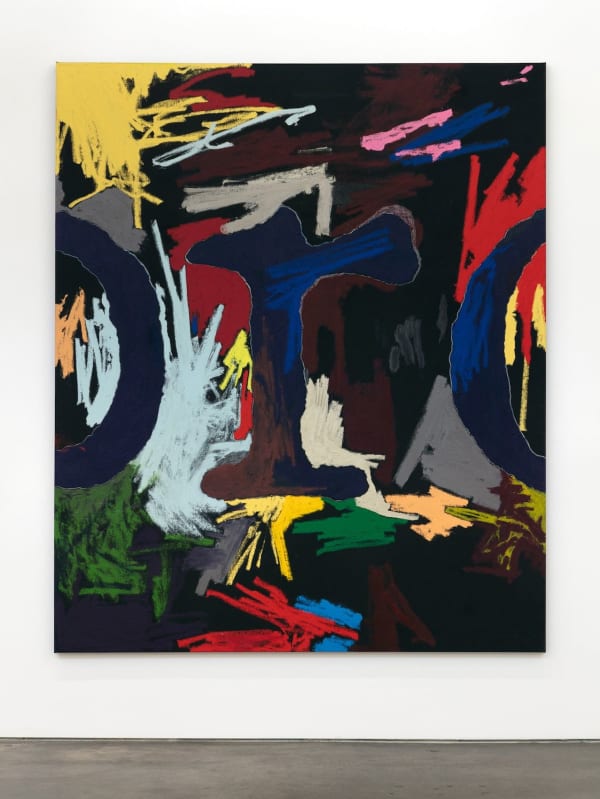William Anastasi
François Ghebaly is proud to present a solo exhibition by the pioneering Conceptual artist William Anastasi, his first in Los Angeles in a decade. The exhibition brings together several key series from the past thirty years, illustrating several important modes of the artist’s thinking and making.
Increasingly recognized for his significant contributions to the development of Conceptualism and Minimalism in the 1960s and 1970s, William Anastasi has built a lifelong practice around ideas of chance, reduction, language, and the unchoreographed movement of the body. Abidingly skeptical of conventional representation, Anastasi’s work bends toward a personal mantra of “simple, as simple as simple—even dumb.” In groundbreaking exhibitions at Dwan Gallery in the 1960s, his self-referential paintings and sculptures embodied the core tenets of post-war Conceptual art.
This exhibition opens with several “unsighted” drawings, works on paper made without looking. Bypassing aesthetic and representational considerations, the works are rather records of the artist’s movement through the city and countryside. Their titles document the places they were made: the subway, a concert, the artist’s coat pocket. Small seismographs of the body in motion, the drawings offer Anastasi what he describes as “strategies to get away from overly intentional mark making,” strategies that evoke the influence of John Cage and other twentieth century explorers of automaticity in art and music.
The notion of automatic drawing emerges again in Donald Duck, painted in 1998. The Disney cartoon is a rare moment of popular iconography in Anastasi’s otherwise spare vocabulary. Yet Donald Duck was a figure that Anastasi drew over and over during his childhood, such that it became a blank form rendered directly from memory. “It was the closest thing to automatic drawing I could do,” Anastasi has said. First appearing in the artist’s debut solo exhibition in 1964, Donald Duck has repeatedly surfaced as an emblem of direct, subconscious drawing, both supermediated and empty.
The exhibition continues with a set of three paintings from the ongoing “Bababad” series, a body of work Anastasi began in 1986. The paintings depict the sound of God’s voice upon the fall of Adam and Eve in James Joyce’s Finnegans Wake, a sound called the “thunderword” in Joycean scholarship. Working in increments of two to five letters per canvas, Anastasi enlarges the one hundred letter long word, bababadalgharaghtakamminarronnkonnbronntonnerronntuonnthunntrovarrhounawnskawntoohoohoo rdenenthurnuk, using graphite to delineate the jagged letter edges and oilstick to elaborate synaesthetic jabs of color. Joyce’s thunderword has been described as “an atheist’s poetic parody of the voice of God,” and in his decades long project of committing the word to massive scale, Anastasi makes a playful yet monumental ode to Joyce and the limits of language.
The power of language is also the subject of the small painting This Jew from 2004. The painting captures and combines multiple strains of the artist’s work. The words “this” and “jew” have each been separate interests for Anastasi, each one containing “dangerous energies” of entirely different kinds. The artist is drawn to the word “this” as a linguistic tautology, a circle that can refer to itself in a closed system. Anastasi, who is not Jewish, sees “jew” as the most charged word in the English language, “in the sense of both positive and negative meaning and energy.” Coupling the two words and adorning them with blind markings, Anastasi creates a condensed expression of linguistic ambiguity.
William Anastasi (b. 1933, Philadelphia, PA) lives and works in New York. He has been the subject of solo exhibitions at numerous museums including the Metropolitan Museum, New York; the Whitney Museum of American Art, New York; the Philadelphia Museum of Art; and the Kunstmuseum Dusseldorf. His works belong in major public collections including the Museum of Modern of Art, New York; the Metropolitan Museum, New York; the Whitney Museum of American Art, New York; the Guggenheim Museum, New York; the Art Institute of Chicago; the National Gallery of Art, Washington, D.C.; the Brooklyn Museum; the Jewish Museum, New York; the Walker Art Center, Minneapolis; the Getty Museum, Los Angeles; the Museum of Contemporary Art, Los Angeles; and the British Museums, London.
-
 William Anastasi, Untitled (Pocket Drawing, 11.04.06), 2006
William Anastasi, Untitled (Pocket Drawing, 11.04.06), 2006 -
 William Anastasi, Donald Duck, 1998
William Anastasi, Donald Duck, 1998 -
 William Anastasi, Untitled (Concert Drawing, St. John the D, 4.28.13), 2013
William Anastasi, Untitled (Concert Drawing, St. John the D, 4.28.13), 2013 -
 William Anastasi, Untitled (Subway Drawing, 12.30.11, Carl Andre, Melissa Kretschmer), 2011
William Anastasi, Untitled (Subway Drawing, 12.30.11, Carl Andre, Melissa Kretschmer), 2011 -
 William Anastasi, Untitled (Subway Drawing, 10.9.10/10.10.10/10.28.10), 2010
William Anastasi, Untitled (Subway Drawing, 10.9.10/10.10.10/10.28.10), 2010 -
 William Anastasi, Untitled (Red Circle), 2015
William Anastasi, Untitled (Red Circle), 2015 -
 William Anastasi, This Jew, 2004
William Anastasi, This Jew, 2004 -
 William Anastasi, Bababad (bro), 2012
William Anastasi, Bababad (bro), 2012 -
 William Anastasi, Bababad (nn), 2013
William Anastasi, Bababad (nn), 2013 -
 William Anastasi, Bababad (ton), 2014
William Anastasi, Bababad (ton), 2014












